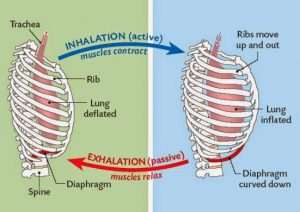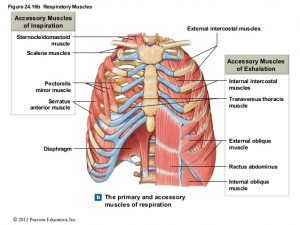As a BASI student I had to do a case study on a specific area or pathology in relation to Pilates. Since my husband is an opera singer I decided to do some research on how Pilates can benefit a classical singer. Turns out Pilates helps with that too! Here is my article:
Classical singers must connect with their breath to effectively produce the correct notes with optimal tonal quality. In order to do this they must recruit the correct abdominal, pelvic floor and lower back muscles to support the diaphragm and control their breath so the proper amount of air pressure can be applied to the vocal cords to produce the desired pitch. The purpose of this case study was to show how singers can benefit from a Pilates program designed to target these supporting muscles and how Pilates can bring balance to their bodies which in turn can enhance their stage movement and presence.
I worked with a 35 year old baritone who sings opera all over the United States to determine the impact a Pilates program would have on his performance. We did two to three, sixty minute Pilates sessions a week over the course of six months. On the whole he feels he is now better connected to the muscles that allow him to control and support his breath, giving him more agility in his voice and more ease in hitting higher notes.
In addition I have spent time speaking to many singers. They all can agree that breath support is a fundamental part of singing but few understand the anatomy behind where that support is coming from and how they can strengthen specific muscles to improve it. Many singers turn to yoga but few integrate Pilates into their weekly regimen.
Anatomy of a Singer
The muscles of the back and abdomen create a support structure and aid the diaphragm and lungs in establishing the movements necessary for breathing.
The diaphragm is a shelf of muscle and tendon that extends across the bottom of the rib cage, dividing the torso in two. Above is the thorax, with the lungs and heart; below is the abdomen. The diaphragm is dome-shaped and curves up toward the center. When the diaphragm contracts it moves downward, allowing the atmospheric pressure outside of the body to rush in and fill the lungs. When it relaxes, the diaphragm returns to its original shape and it pushes the air out of the lungs.

There are two types of intercostal muscles which are found between the ribs. The internal intercostal muscles (in the inside of the rib cage) extend from the front of the ribs and go around the back. The external intercostal muscles (on the outside of the rib cage) wrap around from the back of the rib almost to the end of the bony part of the rib in front. They go downward and outward when viewed from the back. These muscles help expand the chest cavity on an inhale, pulling the ribs out and up.
When a singer is using proper diaphragmatic breathing techniques the intercostals play a large role in aiding the expansion of the ribs and in turn the thoracic cavity. Young singers often experience fatigue of these muscles quickly.
The main abdominal muscles singers use are the transverse abdominis and external and internal obliques. The transverse abdominis play a large role in breathing, especially in forced exhalation. The external and internal obliques allow for higher pressure in the abdomen when compressed, assisting in a more controlled exhalation.
 The back muscles involved in respiration are the quadratus lumborum, which can be felt most easily when the abdominals in front are contracted and one "breathes into the lower back", allowing the diaphragm to push the organs of the abdomen against these muscles. On contraction, they serve as muscles of exhalation. They may also hold the lowest part of the ribs in place during inhalation, allowing the diaphragm to drop down more effectively.
The back muscles involved in respiration are the quadratus lumborum, which can be felt most easily when the abdominals in front are contracted and one "breathes into the lower back", allowing the diaphragm to push the organs of the abdomen against these muscles. On contraction, they serve as muscles of exhalation. They may also hold the lowest part of the ribs in place during inhalation, allowing the diaphragm to drop down more effectively.
Breath support works by contracting the abdominal muscles, creating higher pressure in the abdomen and thorax, allowing the diaphragm's relaxation (and upward rise) to be more carefully controlled. There is less control in relaxing a muscle than there is in contracting it. Therefore, support gives performers a means of controlling their sound, or phonation.
Other accessory muscles used in inhalation are the pectoralis, serratus anterior, subclavius, sternocleidomastoid, scalenus, serratus, latissimus dorsi and levatores costarum.
Case Study
Bernardo is a 6’2”, 185 pound, 35 year old male with an athletic background. He also suffers from mild scoliosis and low back pain. In college Bernardo was a competitive swimmer and also did triathlons for a number of years. He continues to stay active with running and hiking. Several years into his singing career his voice teacher encouraged more recruitment of abdominal and back muscles to aid in supporting his breathing while he sang. This is commonly called breath support. He realized that he needed to focus on strengthening specific abdominal and back muscles to gain better support and control over his voice in order to reach the notes and sing the repertoire he wanted. Although he was already doing basic core strengthening exercises ( sit ups), he recognized he needed some more focused exercises that targeted specific muscles for singers. He decided to turn to Pilates to achieve these career goals.
BASI Pilates Conditioning Program
Based on Bernardo’s needs and financial budget we stuck to a Mat only program. We had a sixty minute session two to three times a week. The Mat program also allowed him to continue his conditioning program while he was traveling for work.
Since Bernardo had never done Pilates before we started with foundation work, focusing on the breath pattern to deepen the exercises. The breath work also gave a direct connection to the breath requirements in singing which was something Bernardo could relate to. I chose exercises that strengthened his obliques, (e.g. chest lift with rotation, spine twist supine, side lift and corkscrew), as well as his back extensors and latissimus dorsi (e.g. cat stretch, swan prep and swimming). We also worked on various planking exercises (e.g. front support) which helped strengthen accessory muscles such as the serratus and pectoralis. Every two weeks I layered on a few more exercises to continue to strengthen and challenge him.
In addition to the Mat exercises we also did the Pole Series (shoulder stretch, overhead and spine twist and side stretch) to give him more mobility in his shoulders and open up his rib cage (side stretch). I also added in the last two weeks arm work with the circle, giving him more challenge and strength in the shoulder girdle.
BASI Mat Program - 6 Week Program
| Block | Exercise | Goal |
| Foundation | Pelvic Curl
Spine Twist Supine Chest Lift Chest Lift w/Rotation Leg Changes |
To create a base in Pilates movement and breath. |
| Abdominal | Hundred Prep
Roll Up Weeks 4-6 Adding: Hundred Double Leg Stretch Single Leg Stretch Criss Cross |
To give a balanced abdominal workout. |
| Spinal Articulation | Spine Stretch
Weeks 3 & 4 Adding: Rolling Weeks 4-6 Adding: Roll Over |
To create better movement in his spine, being mindful of his mild scoliosis. |
| Lateral Flexion/Rotation | Side Lifts
Saw Spine Twist Weeks 4-6 Adding: Corkscrew Side Bend |
Strengthen obliques and spine mobility. The obliques assist with proper breath support in singing. |
| Bridging | Front Support
Back Support Weeks 3 & 4 Adding: Shoulder Bridge Prep Weeks 4-6 Adding: Leg Pull Front Leg Pull Back |
Work on co-contraction of back and abdominal muscles. Strengthen shoulder girdle. |
| Back Extension | Back Extension
Weeks 3-6 Adding: Swimming Cat Stretch Double Leg Kick |
To provide strength and proper recruitment of the back extensors. |
| Arm Work with Circle | Weeks 5 & 6:
Arms Bent Arms Straight Arms Overhead Single Arm Side Press Single Arm Bicep |
Added strength in shoulder girdle. (Accessory muscles in breath support.) |
| Stretches with Pole | Weeks 4-6:
Shoulder stretch Overhead stretch Side stretch Spine Twist |
To provide a stretch in the shoulders and opening of the ribs. |
Conclusion
Bernardo experienced almost immediate benefit from our Pilates sessions. His background as an athlete and understanding of singing anatomy and breath support prior to our sessions allowed him to understand the purpose of the exercises. Pilates also gave him some relief from his mild scoliosis and low back pain which had been plaguing him for years.
Starting with the foundation exercises gave Bernardo a strong base. It also gave him a set of exercises that he could learn to do on his own while traveling. I then layered on week by week additional exercises to each block to flush out the program and give him new challenges that were approachable since we had already covered the fundamental movements. Bernardo felt quick results in his breath support and a reduction in his low back pain. He now can tap into muscles that he was not able to properly do before, resulting in a greater range of notes and strength within his existing register in his singing. In addition to strengthening abdominal and back muscles for breath support, he gained overall body strength and balance. Each session had a complete body workout allowing his entire body to grow stronger as a whole in addition to the focus muscles.
